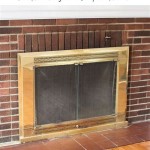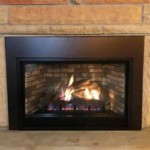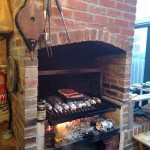Energy Efficient Fireplace Insert: Revolutionizing Home Heating
A fireplace insert is a self-contained heating appliance designed to fit inside an existing masonry or prefabricated fireplace. It improves the heating efficiency of an otherwise inefficient open fireplace. Traditional open fireplaces are notoriously poor at heating a home. They draw warm air up the chimney, resulting in significant heat loss and increased energy consumption. An energy-efficient fireplace insert addresses this issue by providing a controlled and efficient combustion process, maximizing heat output and minimizing energy waste.
The primary goal of an energy-efficient fireplace insert is to transform a decorative fireplace into a functional and effective supplemental heating source. They are available in various fuel types, including wood, gas, and electric, each offering different levels of efficiency and convenience. Modern inserts incorporate advanced technologies such as sealed combustion chambers, catalytic combustors, and programmable thermostats to optimize performance and reduce energy costs. Selecting the right insert requires careful consideration of factors like heating needs, fuel availability, installation requirements, and budget.
Understanding the Efficiency of Fireplace Inserts
The efficiency of a fireplace insert is measured by its ability to convert fuel into usable heat. Traditional open fireplaces are often less than 10% efficient, meaning that over 90% of the heat generated is lost up the chimney. This inefficiency is due to the uncontrolled airflow, incomplete combustion, and the lack of insulation within the firebox. Energy-efficient fireplace inserts, on the other hand, can achieve efficiencies ranging from 70% to 80% or even higher, depending on the fuel type and technology employed.
Several factors contribute to the improved efficiency of fireplace inserts. Sealed combustion chambers prevent air from being drawn from the room, reducing drafts and minimizing heat loss. Catalytic combustors, found in some wood-burning inserts, facilitate more complete combustion of the wood smoke, reducing emissions and increasing heat output. Programmable thermostats allow users to set specific temperature levels, preventing overheating and conserving fuel. Blower fans circulate warm air into the room, enhancing heat distribution and improving overall comfort. The insulation surrounding the firebox prevents heat from escaping into the surrounding structure, further maximizing heat retention within the living space.
The United States Environmental Protection Agency (EPA) plays a crucial role in regulating the efficiency and emissions of wood-burning fireplace inserts. EPA-certified inserts must meet specific standards for particulate matter emissions and combustion efficiency. These standards are designed to protect air quality and promote the use of cleaner-burning technologies. When selecting a wood-burning insert, it is essential to choose an EPA-certified model to ensure compliance with environmental regulations and maximize heating efficiency.
Fuel Type Options and Their Energy Implications
Fireplace inserts are available in three primary fuel types: wood, gas, and electric. Each fuel type offers distinct advantages and disadvantages in terms of energy efficiency, operating costs, and environmental impact.
Wood-burning inserts offer a traditional aesthetic and provide a renewable heating source, provided the wood is sustainably harvested. High-efficiency wood-burning inserts can significantly reduce wood consumption compared to open fireplaces. However, wood-burning inserts require manual loading and ash removal, and they generate particulate matter emissions. Proper wood storage and drying are essential to ensure efficient combustion and minimize emissions. EPA-certified wood-burning inserts utilize advanced technologies such as catalytic combustors and secondary air systems to reduce emissions and improve efficiency.
Gas fireplace inserts offer convenience and ease of use. They can be ignited with the push of a button and provide consistent heat output without the need for manual loading. Gas inserts are typically more efficient than traditional gas fireplaces, but their operating costs can be higher than wood-burning inserts, depending on local gas prices. Gas inserts are available in two types: natural gas and propane. Natural gas is generally less expensive than propane, but its availability may be limited in some areas. Venting requirements for gas inserts can vary depending on the model and local building codes.
Electric fireplace inserts are the easiest to install and operate. They do not require venting and can be plugged into a standard electrical outlet. Electric inserts are highly efficient, converting nearly all of the electrical energy into heat. However, their operating costs can be higher than wood or gas inserts, especially in areas with high electricity prices. Electric inserts offer realistic flame effects and adjustable heat settings, providing a convenient and aesthetically pleasing heating option.
The choice of fuel type depends on individual preferences, heating needs, fuel availability, and budget. Factors to consider include the cost of fuel, the convenience of operation, the environmental impact, and the aesthetic appeal of the flame.
Installation and Maintenance for Optimal Energy Efficiency
Proper installation and maintenance are crucial for ensuring the energy efficiency and longevity of a fireplace insert. Incorrect installation can lead to safety hazards, reduced efficiency, and increased operating costs.
Installation: Installation should be performed by a qualified professional who is familiar with local building codes and safety regulations. The installation process typically involves preparing the existing fireplace, installing a vent liner, connecting the fuel supply, and sealing the insert within the firebox. Proper venting is essential for safe and efficient operation. The vent liner must be sized correctly and installed according to the manufacturer's instructions. Gas and wood-burning inserts require proper ventilation to remove combustion byproducts, preventing carbon monoxide poisoning. Electric inserts do not require venting but must be properly grounded to prevent electrical hazards.
Maintenance: Regular maintenance is essential for maintaining the efficiency and performance of a fireplace insert. For wood-burning inserts, this includes removing ash buildup, cleaning the chimney, and inspecting the firebox for damage. Ash should be removed regularly to prevent it from blocking airflow and reducing combustion efficiency. Chimney cleaning should be performed annually to remove creosote buildup, which can be a fire hazard. The firebox should be inspected for cracks or damage, which can compromise the integrity of the insert. Gas inserts require regular inspection of the burner, pilot light, and venting system. The burner should be cleaned to remove debris and ensure proper combustion. The pilot light should be inspected to ensure it is burning properly. The venting system should be inspected for leaks or blockages. Electric inserts typically require minimal maintenance, but the heating element and fan should be cleaned periodically to remove dust and debris.
Following the manufacturer's instructions for installation and maintenance is crucial for ensuring the safe and efficient operation of a fireplace insert. Regular maintenance can help prevent problems, extend the life of the insert, and maximize energy savings. Neglecting maintenance can lead to reduced efficiency, increased operating costs, and potential safety hazards.
Choosing an energy-efficient fireplace insert is a significant investment that can improve home comfort, reduce energy costs, and enhance the aesthetic appeal of a living space. By carefully considering the factors discussed, homeowners can select the right insert to meet their specific needs and enjoy the benefits of efficient and reliable supplemental heating.

Fireplace Inserts 5 Money Saving Benefits Efficient Heating

What Will Make Your Fireplace Energy Efficient Rockford Chimney

Energy Efficient Wood Burning Fireplaces

Top 5 Reasons To Consider A Fireplace Inserts Wi Ia Il

Why A Wood Burning Fireplace Insert Bethesda Md Service

Energy Efficiency Epa Certified Units Appliances

Ventis Hei240 Wood Fireplace Insert Mace Energy Supply

The Benefits Of A Modern Wood Burning Fireplace Insert Bart Fireside

Pacific Energy Super Woodburning Fireplace Insert Fergus

Energyking Bay Insert Fireplace








